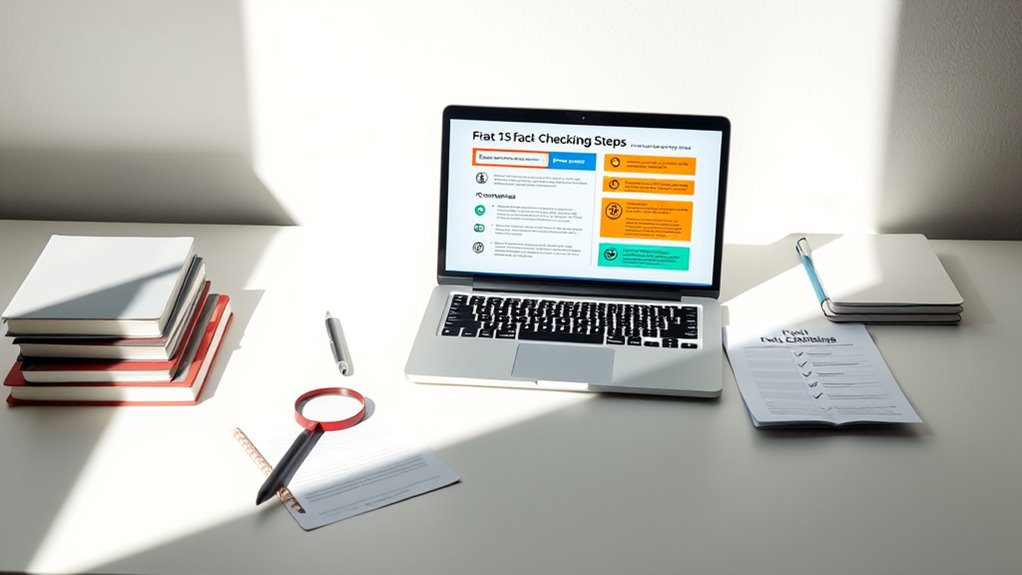To maintain effective fact-checking routines, focus on clear, manageable steps like understanding the claim, gathering credible evidence, and verifying through multiple sources. Set routines that fit your schedule and prioritize claims that matter most. Use helpful tools like reputable websites and search operators to streamline your efforts. Keep your process consistent and simple, documenting sources for credibility. If you keep refining these steps, you’ll build a sustainable framework you can rely on over time.
Key Takeaways
- Establish clear, specific criteria for credible evidence, focusing on reputable sources and official documents.
- Develop a step-by-step process: understand the claim, gather evidence, verify through multiple sources, and assess relevance.
- Set manageable goals and routines with dedicated time blocks to ensure consistency without overwhelm.
- Use trusted resources, fact-checking tools, and search techniques to streamline the verification process efficiently.
- Maintain a sustainable framework by documenting sources, focusing on core principles, and adapting tasks into simple routines.

Have you ever wondered how we determine whether a claim is true or false? It’s a question that sits at the core of fact-checking, and establishing a reliable framework can feel overwhelming. The key is to develop systems that are practical and sustainable, so you don’t burn out or get bogged down by complexity. When you approach fact-checking, start by defining clear criteria for what counts as evidence. This means deciding whether you’ll prioritize official documents, expert testimony, or data from reputable sources. Being specific about your sources helps you stay focused and prevents you from wasting time chasing down every piece of information that pops up.
Next, create a step-by-step process that guides your work. For example, begin by understanding the claim thoroughly—what exactly is being asserted? Then, gather relevant evidence, checking its credibility and relevance along the way. It’s essential to verify the information from multiple sources whenever possible. Cross-referencing reduces the risk of bias or errors slipping through. As you evaluate evidence, ask yourself whether it directly supports or refutes the claim. Avoid getting sidetracked by tangential issues; stay focused on the core question.
To keep your fact-checking sustainable, set manageable goals. Don’t try to fact-check every claim you see; instead, prioritize those that matter most—such as claims that influence public opinion or policy. Allocate dedicated blocks of time for this work, and be consistent. Creating routines makes fact-checking less daunting and helps you stay committed over the long haul. Also, keep a record of your sources and conclusions. This documentation not only boosts your credibility but also makes it easier to revisit or update your findings later.
Prioritize key claims, set routines, and document sources to ensure sustainable and credible fact-checking efforts.
Another practical tip is to develop a set of go-to resources and tools. Bookmark reputable fact-checking sites, utilize search operators to narrow down results, and leverage fact-checking software if available. Over time, these resources become part of your process, making it more efficient. Remember, maintaining a fact-checking framework isn’t about perfection; it’s about establishing a reliable, repeatable process that fits your capacity. Reconnecting with the core principles of personal growth can help you stay motivated and improve your skills over time. By focusing on clarity, consistency, and manageable steps, you can stay committed and produce accurate, meaningful work without feeling overwhelmed.
Ultimately, a straightforward, well-structured approach keeps your fact-checking efforts sustainable. It allows you to build trust in your work and ensures your efforts stay consistent over time. When you develop a framework that’s easy to follow, you turn a potentially daunting task into a manageable routine—one that you can maintain day after day.
Frequently Asked Questions
How Do I Start Implementing a Fact-Checking Framework?
To start implementing a fact-checking framework, identify your main sources of information and set clear criteria for verifying facts. Create a step-by-step process, like cross-referencing multiple reliable sources, checking for biases, and documenting your findings. Use tools such as fact-checking websites or software to streamline the process. Practice regularly to improve accuracy, and keep your framework flexible to adapt to new information or challenges as they arise.
What Tools Are Best for Ongoing Fact Verification?
You should consider tools like Factmata, AdVerif.ai, or ClaimBuster for ongoing fact verification. These platforms help you automate the process, flagging questionable content quickly. Use browser extensions like NewsGuard or Media Bias/Fact Check to assess sources in real-time. Incorporate fact-checking APIs into your workflow to streamline updates. Regularly update your tools and stay informed about new features to keep your fact verification effective and manageable.
How Can I Ensure Team Consistency in Fact-Checking?
Imagine your team as a well-oiled machine—consistency is the key. To guarantee this, establish clear guidelines and standardized procedures everyone follows. Regular training keeps everyone sharp, and shared checklists foster uniformity. Use collaborative tools to monitor progress and provide feedback. By creating a culture of accountability and open communication, you make fact-checking second nature, turning your team into a seamless, reliable fact-verifying force that catches errors before they spread.
What Are Common Pitfalls in Maintaining Fact-Checking Frameworks?
You often fall into pitfalls like neglecting regular updates, which make your framework outdated, or relying too heavily on automation, risking overlooked nuances. You might also overlook team training, leading to inconsistent fact-checking standards. Additionally, failing to document processes clearly can cause confusion. To avoid these issues, prioritize ongoing training, keep your guidelines current, and ensure open communication within your team to maintain a reliable fact-checking system.
How Do I Measure the Effectiveness of My Fact-Checking Process?
To measure your fact-checking process’s effectiveness, track accuracy rates by reviewing a sample of your work regularly. Monitor turnaround times to guarantee timely responses and gather feedback from your audience to gauge trust and clarity. Additionally, compare your findings with reputable sources and note any corrections needed. Constantly analyze these metrics to identify areas for improvement, assuring your fact-checking remains reliable and efficient.
Conclusion
Choosing a fact-checking framework is like picking the right compass — it guides you through a sea of information with confidence. By selecting a system that fits your needs and sticking with it, you turn the formidable task of verification into a manageable journey. Remember, consistency is your anchor, keeping you steady amid the waves of misinformation. With the right framework in hand, you’ll navigate the truth with clarity and purpose, steering clear of the stormy waters of falsehoods.









